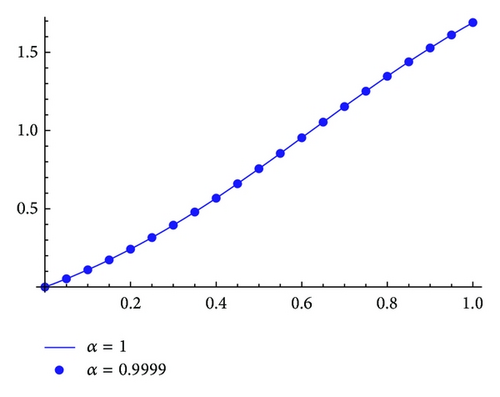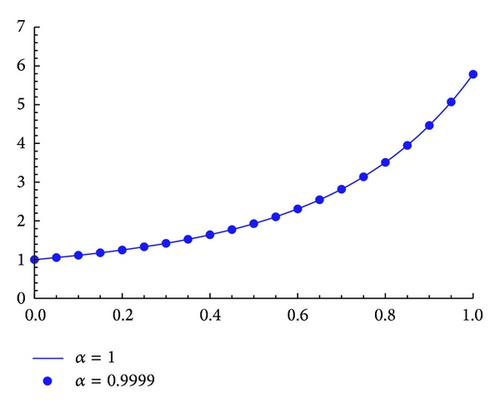Tau-Path Following Method for Solving the Riccati Equation with Fractional Order
Abstract
A formulation for the fractional Legendre functions is constructed to find the solution of the fractional Riccati equation. The fractional derivative is described in the Caputo sense. The method is based on the Tau Legendre and path following methods. Theoretical and numerical results are presented. Analysis for the presented method is given.
1. Introduction
Recently, many papers on fractional boundary value problems have been studied extensively. Several forms of them have been proposed in standard models, and there has been significant interest in developing numerical schemes for their solutions. Several numerical techniques are used to solve such problems such as Laplace and Fourier transforms [1, 2], Adomian decomposition and variational iteration methods [3, 4], eigenvector expansion [5], differential transform and finite differences methods [6, 7], power series method [8], collocation method [9], and wavelet method [10, 11]. Many applications of fractional calculus on various branches of science such as engineering, physics, and economics can be found in [12, 13]. Considerable attention has been given to the theory of fractional ordinary differential equations and integral equations [14, 15]. Additionally, the existence of solutions of ordinary and fractional boundary value problems using monotone iterative sequences has been investigated by several authors [16–20].
Riccati equation with fractional order has been discussed by many researchers using different techniques such as collocation method based on Muntz polynomials [21], homotopy perturbation method [22], and series solution method [23].
In this paper we study the Tau-path following method for solving the Riccati equation with fractional order. We organize this paper as follows. In Section 2, we present basic definitions and results of fractional derivatives. We extend basic results to path following method for the fractional case. In Section 3, we introduce the fractional-order Legendre Tau method with path following method for solving the Riccati equation with fractional order. In Section 4, we present some numerical results to illustrate the efficiency of the presented method. Finally, we conclude with some comments in the last section.
2. Preliminaries
In this section, we review the definition and some preliminary results of the Caputo fractional derivatives, as well as, the definition of the fractional-order Legendre functions and their properties.
Definition 1. The Riemann-Liouville fractional integral operator Iα of order α > 0 on the usual Lebesgue space L1[0,1] is given by
- (1)
Iα exists for any x ∈ [0,1],
- (2)
IαIβ = Iα+β,
- (3)
IαIβ = IβIα,
- (4)
Iαxγ = (Γ(γ + 1)/Γ(α + γ + 1))xα+γ.
Definition 2. The Caputo fractional derivative of order α is defined by
- (1)
DαIαf(x) = f(x),
- (2)
,
- (3)
DαDβf(x) = DβDαf(x) = Dα+βf(x), x > 0,
- (4)
Dαc = 0, where c is constant,
- (5)
,
- (6)
, where c1, c2, …, cm are constants.
The basic concept of this paper is the Legendre polynomials. For this reason, we study some of their properties.
Definition 3. The Legendre polynomials {ℒk(x) : k = 0,1, 2, …} are the eigenfunctions of the Sturm-Liouville problem
- (1)
, where ,
- (2)
ℒi+1(x) = ((2i + 1)/(i + 1))xℒi(x)−(i/(i + 1))ℒi−1(x), for i⩾1,
- (3)
ℒi(±1) = (±1) i.
- (1)
,
- (2)
Si+1(z) = ((2i + 1)/(i + 1))(2z − 1)Si(z)−(i/(i + 1))Si−1(z), for i⩾1,
- (3)
Si(0) = (−1) i and Si(1) = 1.
- (1)
,
- (2)
, for i⩾1,
- (3)
and ,
- (4)
and .
In the next theorem, we state one of the main properties of the fractional Legendre functions which will be used later in this paper.
Theorem 4. For any nonnegative integers p and q,
Proof. For any nonnegative integers p and q,
For the proof of this case, see [25]. Using the change of variables x = 2z − 1 and z = tα, we obtain the result of the theorem.
Another important result which will facilitate applying the Tau method for fractional case is given in Theorem 5.
Theorem 5. Let u ∈ C[0,1] and u′(t) be a piecewise continuous function on [0,1]. Then, u(t) can be written in the infinite expansion as , where
Proof. If u ∈ C1[−1,1] and u′′(x) is a piecewise continuous function on [−1,1], converges uniformly to u(x) on [−1,1], see [26–28]. Let h : [0,1] → [−1,1] by
Theorem 6 gives the relation between the coefficient of the series solution of Dαu(t) and the coefficients of the series expansion of u(t).
Theorem 6. Let u ∈ C1[0,1] and u′′(t) be a piecewise continuous function on [0,1]. Then, converges uniformly on [0,1] to Dαu(t), where
Proof. Let for n = 0,1, 2, …. From Theorem 5, Sn(t) converges uniformly to u(t) on [0,1]. Since u ∈ C1[0,1] and u′′(t) is a piecewise continuous function on [0,1],
3. Fractional-Order Legendre Tau-Path Following Method
- (1)
H ∈ C∞(ℜN+1 × [0,1]),
- (2)
H(0, 0) = 0,
- (3)
(∂H/∂Y)(0, 0) = A.
- (1)
,
- (2)
∥γ′(s)∥ = 1, where ∥·∥ is the Euclidean norm,
- (3)
H′(γ(s))γ′(s) = 0.
4. Numerical Results
In this section, we implement the Tau-Path following method to the nonlinear fractional Riccati differential equations. Two examples of nonlinear fractional Riccati differential equations are solved to show the efficiency of the presented method.
Example 7. Consider the following initial value problem [32]:
The matrices in (33) are
It is easy to see that |det(A)| = 1 which means A is nonsingular. Define the error by
Then, the absolute maximum of the error for different values of α are given in Table 1 for N = 16.
The exact solution when α = 1 is . The graphs of the approximate solution when α = 0.9999 and the graph of the exact solution when α = 1 are given in Figure 1.
| α | Error |
|---|---|
| 0.5 | 1*10−9 |
| 0.9 | 2*10−10 |
| 0.99 | 1.2*10−10 |
| 0.9999 | 1.7*10−12 |

Example 8. Consider the following initial value problem [32]:
The matrices in (33) are
It is easy to see that |det(A)| = 1 which means A is nonsingular. Define the error by
Then, the absolute maximum of the error for different values of α is given in Table 2 for N = 16.
The exact solution when α = 1 is y(x) = (x(J−3/4(x2/2)Γ(1/4) + J3/4(x2/2)Γ(3/4)))/(J1/4(x2/2)Γ(1/4) − 2J−1/4(x2/2)Γ(3/4)) where Jν(x) is the Bessel function of first kind. The graphs of the approximate solution when α = 0.9999 and the exact solution when α = 1 are given in Figure 2.
| α | Error |
|---|---|
| 0.5 | 2.7*10−10 |
| 0.9 | 8.6*10−11 |
| 0.99 | 5.4*10−11 |
| 0.9999 | 2.1*10−13 |

Conflict of Interests
The authors declare that there is no conflict of interests regarding the publication of this paper.
Acknowledgments
The authors would like to express their appreciation for the valuable comments of the reviewers. The authors also would like to express their sincere appreciation to United Arab Emirates University for the financial support of Grant no. COS/IRG-15/14.




